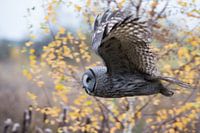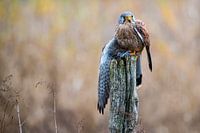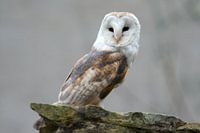Buy the photo Barn owl by Diane Jordan on canvas, ArtFrame, poster and wallpaper, printed on demand in high quality.
About "Barn owl"
by Diane Jordan
About the artwork
The barn owl (Tyto alba) is one of the best known and most fascinating owl species in the world. It is known for its striking, heart-shaped face and has a wide distribution that takes it from Europe to Australia and large parts of Asia. Its most distinctive feature is the white, heart-shaped facial veil, which gives it an unmistakable appearance. This veil helps to focus sound to improve hunting at night. The barn owl has very soft, often reddish-brown to grey plumage with white patches on the underside. The body is relatively slender and the wings are long and broad. It is a medium-sized owl, about 33 to 39 cm long, with a wingspan of 80 to 95 cm. Its eyes are black and relatively large in relation to its head. The barn owl has a very wide distribution and can be found in almost all continents of the world, with the exception of cold regions such as the Arctic and Antarctic.
It is widespread in Europe and can also be found in urban areas. In Germany, however, it is rarer than other owl species and is often associated with old buildings and barns. Barn owls favour open landscapes such as meadows, fields and agricultural areas, but also rural and urban mountainous areas. They often nest in old churches, towers, barns or other buildings that serve as a substitute for caves.
They are often found near human settlements, as these places offer many hunting opportunities and nesting sites are available in the form of empty buildings or nesting boxes.

About Diane Jordan
It's not the camera (Nikon Z8), but who is behind it ; )) Diane.. Read more…
 Netherlands
Netherlands Ordered in August 2019
Ordered in August 2019
 Germany
Germany Ordered in February 2021
Ordered in February 2021
 Netherlands
Netherlands Ordered in April 2018
Ordered in April 2018
 Germany
Germany Ordered in October 2022
Ordered in October 2022
 Netherlands
Netherlands Ordered in February 2019
Ordered in February 2019
 Germany
Germany Ordered in August 2019
Ordered in August 2019
 Netherlands
Netherlands Ordered in July 2020
Ordered in July 2020
 Germany
Germany Ordered in May 2019
Ordered in May 2019
 Netherlands
Netherlands Ordered in August 2019
Ordered in August 2019
 Germany
Germany Ordered in March 2022
Ordered in March 2022
 Netherlands
Netherlands Ordered in December 2021
Ordered in December 2021
 Netherlands
Netherlands Ordered in October 2021
Ordered in October 2021
About the material
ArtFrame™
Interchangeable Art Prints
- High-quality print
- Easily interchangeable
- Acoustic function
- Large sizes available
Discover the artworks of Diane Jordan
 Warehouse districtDiane Jordan
Warehouse districtDiane Jordan Speicherstadt BridgeDiane Jordan
Speicherstadt BridgeDiane Jordan Hamburg CathedralDiane Jordan
Hamburg CathedralDiane Jordan Great horned owlDiane Jordan
Great horned owlDiane Jordan KestrelDiane Jordan
KestrelDiane Jordan Barn owlDiane Jordan
Barn owlDiane Jordan Shrike falconDiane Jordan
Shrike falconDiane Jordan Checkerboard flowerDiane Jordan
Checkerboard flowerDiane Jordan Poppy seedsDiane Jordan
Poppy seedsDiane Jordan Hamburg - city of bridgesDiane Jordan
Hamburg - city of bridgesDiane Jordan Hamburg moated castleDiane Jordan
Hamburg moated castleDiane Jordan













 Photo wallpaper
Photo wallpaper Photography
Photography Serene Peace
Serene Peace









